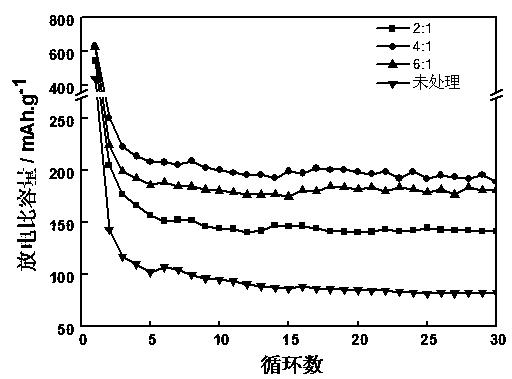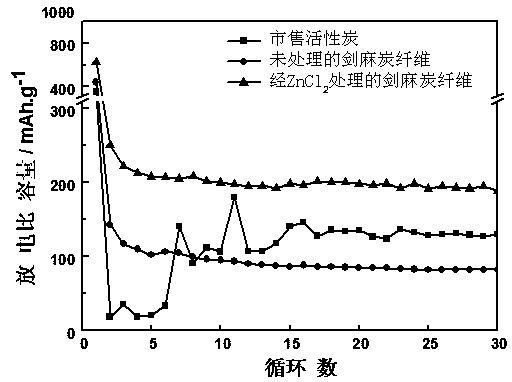Method for preparing anode material of lithium ion battery based on chemically-activated sisal carbon fiber
A lithium-ion battery and sisal fiber technology, applied in chemical instruments and methods, battery electrodes, inorganic chemistry, etc., can solve problems such as short service life, high cost, and poor safety
- Summary
- Abstract
- Description
- Claims
- Application Information
AI Technical Summary
Problems solved by technology
Method used
Image
Examples
Embodiment 1
[0016] (1) The raw fibers stripped from sisal leaves are rubbed to remove dandruff, washed with deionized water, and then dried at 80°C for 12 hours.
[0017] (2) Take three parts (6g each) of the sisal fibers obtained in step (1) and place them in beakers respectively, and use 25% ZnCl 2 The solution is according to the ZnCl 2 The mass ratio of sisal fiber and sisal fiber is 2:1, 4:1, 6:1 impregnation than soaking for 24 hours, then ZnCl 2 The residual solution was washed with water until neutral, and dried at 80°C for 12 hours.
[0018] (3) Put the sisal fibers obtained in step (2) into 50ml crucibles respectively, then put them into a vacuum tube resistance furnace, and carbonize for 1 hour under a nitrogen atmosphere with a gas flow rate of 40ml / min, and the carbonization temperature is 900°C. The heating rate was 3°C / min, and black fibrous sisal activated carbon fibers were obtained after natural cooling, which were bagged and sealed for storage.
[0019] (4) The sisal...
PUM
| Property | Measurement | Unit |
|---|---|---|
| particle size | aaaaa | aaaaa |
Abstract
Description
Claims
Application Information
 Login to View More
Login to View More - R&D
- Intellectual Property
- Life Sciences
- Materials
- Tech Scout
- Unparalleled Data Quality
- Higher Quality Content
- 60% Fewer Hallucinations
Browse by: Latest US Patents, China's latest patents, Technical Efficacy Thesaurus, Application Domain, Technology Topic, Popular Technical Reports.
© 2025 PatSnap. All rights reserved.Legal|Privacy policy|Modern Slavery Act Transparency Statement|Sitemap|About US| Contact US: help@patsnap.com


